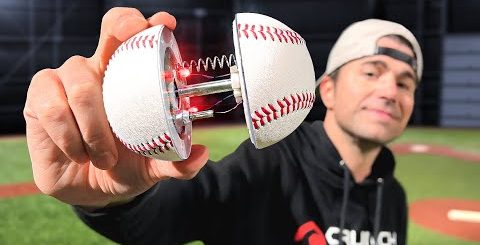Watch gravity pull two metal balls together
Visit https://www.brilliant.org/stevemould for 30 days free access to Brilliant.
The first 200 people will get 20% off an annual premium subscription.
The cavendish experiment shows that even the very week force of gravity can be seen between two room scale objects. Even with the naked eye.
MyLundScience’s video on the Cavendish experiment: https://youtu.be/MbucRPiL92Q
A video derivation of the Cavendish experiment equation: https://www.youtube.com/watch?v=RacOKBBdMeQ
Experimental procedure: https://www.ld-didactic.de/documents/en-US/GA/GA/3/332/332101de.pdf
Equipment user manual: https://www.ld-didactic.de/documents/en-US/EXP/P/P1/P1131_e.pdf
You can buy my books here:
https://stevemould.com/books
You can support me on Patreon and get access to the exclusive Discord:
https://www.patreon.com/stevemould
just like these amazing people:
Alex Hackman
Glenn Sugden
Tj Steyn
Pavel Dubov
Jeremy Cole
Brendan Williams
Frank Hereford
Lukas Biewald
Heather Liu
Grant Hay
John Zelinka
Paul Warelis
Matthew Cocke
Nathan Blubaugh
Marshall Fitzpatrick
Damien Szerszinski
Lizzy and Jack
Twitter: http://twitter.com/moulds
Instagram: https://www.instagram.com/stevemouldscience/
Facebook: https://www.facebook.com/stevemouldscience/
Buy nerdy maths things: http://mathsgear.co.uk








Here’s a fun fact: if you scaled down the earth and moon system until the earth was the size of a bowling ball (keeping the density the same), it would still take the moon 27 days to orbit the earth. This is true in general. Like if you scaled down the ISS as well, that would take the same 90 minutes to orbit as it does now. It’s true at any scale, not just bowling ball scale! The sponsor is Brilliant: Visit https://www.brilliant.org/stevemould for 30 days free access. The first 200 people will get 20% off an annual premium subscription.
Great video once again Steve. You were mentioned in a question in my school’s yearly Christmas quiz, seeing at you went there.
So why my tennis ball does not orbit my bowling ball every 27 days then?
How do we know if the masses move towards each other due to gravity or the motion results from the rotation of the earth?
@@piranhaofserengheti4878 Similar reason why a magnet sticks to the fridge even though it’s still pulled down
Would using flat objects instead of spheres make a difference?
The Cavendish experiment and Millikan’s oil drop experiment were the two historical experiments that really struck me when I was studying physics. Being able to see gravity directly, or being able to see the influence of a single electron’s charge – it’s just mind blowing. I love Von Jolly’s version of the thing as well.
When I was doing physics in university I did both of those experiments and I completely agree. Millikan’s oil drop is especially interesting as measuring such a single charge seems absolutely impossible initially, way harder than just showing the effects of gravity between two objects in a room.
Me too. I consider it to be one of most important experiment in science history. The another one is Michalson Morley Morley experiment paving way for theory of relativity
(where gravity is shielding from cosmic radiation gravity can never exeed the speed of light )
I got to do Millikan’s oil drop experiment in college, and got pretty decent results (I think we were within 50% of the actual value, and we had distinct peaks for 1e and 2e charges). There’s something really magical about being able to measure such a tiny quantity to any degree of precision.
I wish I knew about this experiment when I was a teenage flat earth tard. Would have saved me a year or 2 😅
Finally, someone on YouTube has calculated the proper deflection angle! Props to the author. 🙂
Before that, I watched a bunch of videos about someone quickly cobbling together a setup to observe gravity in their room without even realizing how tiny the deviation should be. That includes the video the author showed as example.
Yeah, that other video immediately seemed glaringly wrong. Just intuitively, if that reaction really was due to gravity then you’d expect to almost feel pulled by big rocks and buildings when you walk by.
@@joeomundson
Its not that glaring since the video was playing at 30x speed
If Steve also dropped rocks from a height, found g, and then calculated the mass of the earth, it would be doubly cool.
@@-ZH I know it was sped up but even still the magnitude seemed like a lot
I’m glad you showed your homemade experiment even though it didn’t work. That took balls.
of 14kg steel
We had this experiment as a possible advanced lab during undergraduate. Most people purposefully avoided it because it was notoriously finicky. There, it was pretty big torsional pendulum placed inside a Faraday Cage. Improper grounding will absolutely mess up the experiment. A friend of mine did the experiment and discovered a grounding fault that was the source of all her error; no one knew how long the fault was present. There was also a case when I was taking the class, that one of the members of the group doing the Cavendish experiment came into the common room very animated a cursing. We immediately asked him what was wrong, and apparently a friend in the class though it would be funny to lightly slap the faraday cage. That one impulse set the pendulum oscillating so much it was going to take most of the remaining lab period to settle down (we had three weeks to do each of these experiments); I’m pretty sure the friend got in trouble with our professor, both specifically for doing that to them, and more generally for incredibly inappropriate laboratory behavior and, effectively, data tampering.
Brings back memories of being a physics student and measuring G at Imperial College. In our lab experiment we had equipment that moved and tracked the laser beam resulting in the positions being recorded, thus making the final analysis easier 😀
No way, I’m an ICL Physics student, too!
Thank you, Steve. The Cavendish Experiment from MrLund has always annoyed me because it is very clear that the movement is too big for what one would expect of the actual force of gravity. So many comments on that video think that is real. In fact, even the most subtle air current in your room could make more impact than the force of gravity. I was ecstatic to see how you would deal with the experiment, as it is a very hard to replicate. Watching you use professional equipment in a lab didn’t disappoint!
Also he never did the obvious next step which would be to move the bricks to the other side and see if the thing turns the other way. And he didn’t film for nearly long enough.
Ah, the perturbation of air currents as a result of the stationary bricks could well have been the cause of the deviation.
It’s not really hard to replicate. We did it at high school in a 90 minute lesson. Came out fairly close to the real gravitational constant. Standard experiment at my school.
@@poznaniak8349 In the video Steve mentions the awful amount of time that the torsion balance takes to settle in. I’m skeptical this experiment can be done properly in 90 minutes.
This is nothing but electrostatic attraction.
Gravity is a myth.
If you can’t measure it, it’s not real.
Cavendish was a fraud.
There is no way his crappy experiment worked.
We are trapped in lower earth orbit.
No one leaves lower earth orbit.
Nasa is a fraud.
Nasa is a giant CGI factory.
Check out a list of nasa vendors and see where they spend our money.
Great job, Steve! 10% error is typical for what physics majors get when they do this lab experiment using the 2nd apparatus you used.
What about using a bunch of photoresistors to measure the fluctuations in the laser? It could keep measuring for longer, and would probably give a better value?
@@tormodhag6824 yup, and then you find out more precise G 😀
I was thinking similarly – with a measuring rule on the whiteboard and a time-lapse overnight 😀
@@tormodhag6824 Real undergrad physics lab experiments are always messy, and you need a human to see what should and shouldn’t be counted as “data”. The experiment Steve shows with the physics lab apparatus is one we use to educate physics students in experimental techniques — especially the use of mirror and laser to measure angular changes; it’s not to try and improve the known value of “G”.
@@tormodhag6824
I wonder if a jewlled bearing (like those in high-end mechanical watches, which are as close to frictionless as one can easily get) would make the results more easily observed? (Though, that would complicate the measurement of G… Increasing the length of the wire suspending the moving weight would also aid in taking an accurate measurement, eh?)
Once in college, a pal and I built a foucault’s pendulum, just to see it work, which it did! (I mean, of course it did. Cool to see, though.)
We used monofilament fishing line to hang the (45lb) weight, I can’t think of any line as light and strong as that… What is used in these setups? Did he mention that?
Cheers!
This experiment is uber sensitive so even the tiniest things can disturb and/or affect the results. For example, even having the air conditioner on or a window open somewhere can affect it. That’s no doubt why that smaller version seemed to have its moving parts inside a vacuum chamber.
I’ve done this experiment before with something very much like what you used at the end. This experiment is unbelievably sensitive to vibrations. If you plot the position of the laser over time you can see people walking across the room in the plot. That’s why you should do it when nobody else is around and have the laser pointing at a surface as far away as you can get it so that the person taking the measurements doesn’t disrupt the experiment moving around.